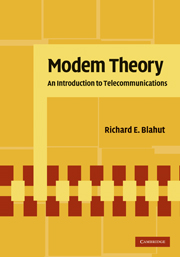Book contents
- Frontmatter
- Contents
- Preface
- Dedication
- 1 Introduction
- 2 Baseband Modulation
- 3 Baseband Demodulation
- 4 Sequences at Baseband
- 5 Passband Modulation
- 6 Passband Demodulation
- 7 Principles of Optimal Demodulation
- 8 Synchronization
- 9 Codes for Digital Modulation
- 10 Codes for Data Transmission
- 11 Performance of Practical Demodulators
- 12 Secure Communications
- Bibliography
- Index
3 - Baseband Demodulation
Published online by Cambridge University Press: 05 June 2012
- Frontmatter
- Contents
- Preface
- Dedication
- 1 Introduction
- 2 Baseband Modulation
- 3 Baseband Demodulation
- 4 Sequences at Baseband
- 5 Passband Modulation
- 6 Passband Demodulation
- 7 Principles of Optimal Demodulation
- 8 Synchronization
- 9 Codes for Digital Modulation
- 10 Codes for Data Transmission
- 11 Performance of Practical Demodulators
- 12 Secure Communications
- Bibliography
- Index
Summary
The function of a digital demodulator is to reconvert a waveform received in noise back into the stream of data symbols from the discrete data alphabet. We usually regard this datastream as a binary datastream. A demodulator is judged by its ability to recover the user datastream with low probability of bit error even when the received channel waveform is contaminated by distortion, interference, and noise. The probability of symbol error or bit error at the demodulator output is also called the symbol error rate or the bit error rate. The demodulator is designed to make these error rates small. We shall concentrate our discussion on optimum demodulation in the presence of additive noise because additive noise is the most fundamental disturbance in a communication system.
The energy per data bit is the primary physical quantity that determines the ability of the communication system to tolerate noise. For this purpose, energy (or power) always refers to that portion of the energy in the waveform that reaches the receiver. This will be only a small fraction of the energy sent by the transmitter.
The study of the optimum demodulation of a waveform in additive noise is an application of the statistical theory of hypothesis testing. The basic principles are surprisingly simple and concise. The most basic principle, and the heart of this chapter, is the principle of the matched filter. A very wide variety of modulation waveforms are demodulated by the same general method of passing a received signal through a matched filter and sampling the output of that matched filter.
- Type
- Chapter
- Information
- Modem TheoryAn Introduction to Telecommunications, pp. 58 - 93Publisher: Cambridge University PressPrint publication year: 2009



